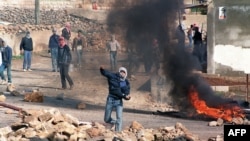This week marks the anniversary of the start of the First Intifada, a 1987 uprising in which Palestinians for the first time worked in unison – albeit in vain – against Israel's occupation of lands captured in the 1967 Six Day War. The wave of violence starting in 1987 lasted six years and marked a turning point in the larger Israeli Palestinian conflict.
After 34 years, the incident that sparked the First Intifada is still a subject of debate.
Israel says it was a traffic accident in which a military jeep accidentally hit a car carrying Palestinian workers in the Jabalia refugee camp in the Gaza Strip, killing four of them.
Palestinians alleged the soldiers intentionally hit the civilian vehicle. The next day, after the funerals, clashes broke out between Israeli soldiers and families of the victims, says Palestinian journalist Safwat al-Kahlout.
He says that afterward, victims' families attacked the police station and students gathered, surrounding a truck belonging to Israeli security forces and started throwing stones. The soldiers fled to a nearby house and opened fire, killing one Palestinian.
Palestinians began organizing a coordinated resistance to Israeli occupation of the West Bank and Gaza Strip. They began mass demonstrations all over the West Bank and Gaza Strip, which, along with east Jerusalem, were the areas Palestinians claimed for a future Palestinian state.
Muayad Abdul Sama, a former activist and prisoner, says that Palestinian awareness grew as they formed volunteer, student and cultural committees which all shared the same national dream to end the occupation peacefully.
The world media provided extensive coverage of the violence. But Mary King, a specialist at conflict resolution at the Costa Rica-based University for Peace, says there was something going on that had never been seen before. The First Intifada, she says, marked the first time that modern Palestinian society worked together to achieve a goal.
"The media gave tremendous coverage, but they actually missed the point," King said. "What was actually taking place was that the entire Palestinian society was unifying to work to lift Israeli military occupation."
The demonstrations often turned violent as Palestinian youth threw stones at Israeli soldiers who responded with tear gas, stun grenades and sometimes live fire.
Over six years starting in 1987, more than 1,000 Palestinians and 160 Israelis were killed in confrontations.
The First Intifada ended after Israel and the Palestinians began secret negotiations in Oslo to reach a peace agreement.
In 1993 they announced the Oslo peace accords, a roadmap that was supposed to lead to the establishment of a Palestinian state within five years.
There was widespread optimism in both Israeli and Palestinian society, but that optimism proved short-lived.
In 2000, a second, much more violent intifada broke out that – for many on both sides – spelled the end of hope for lasting peace between the two peoples.










